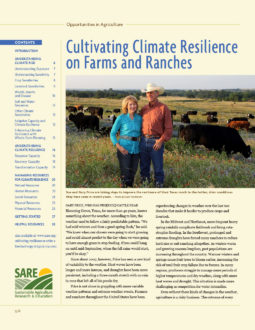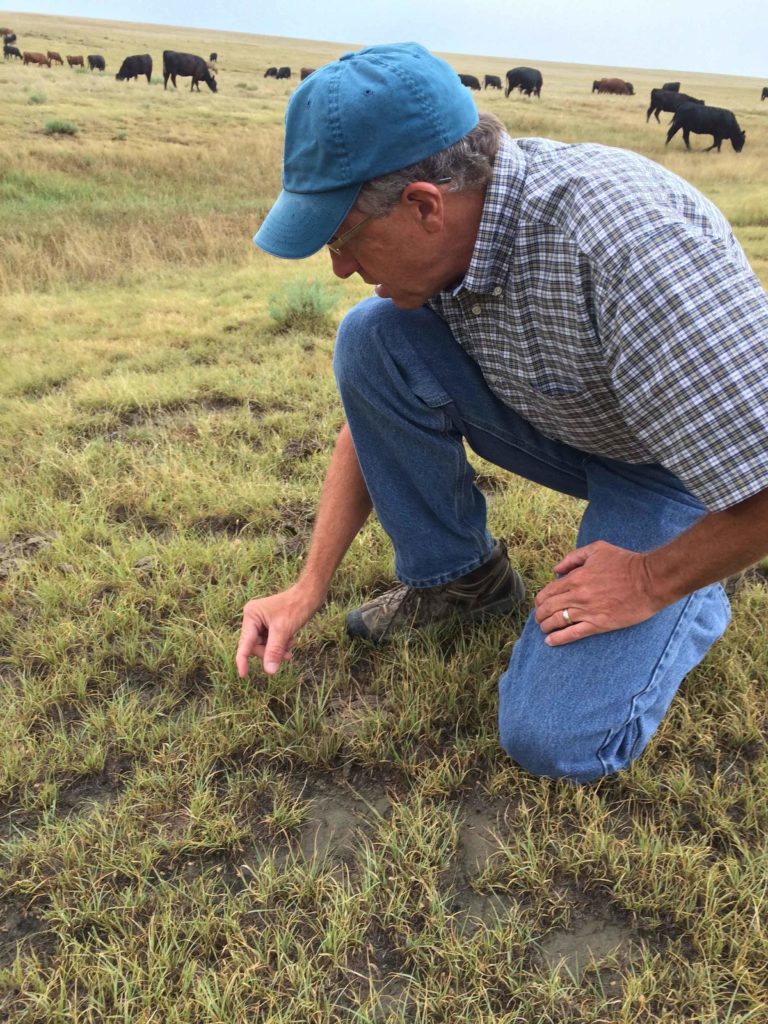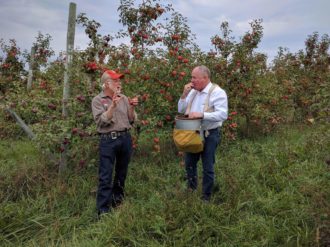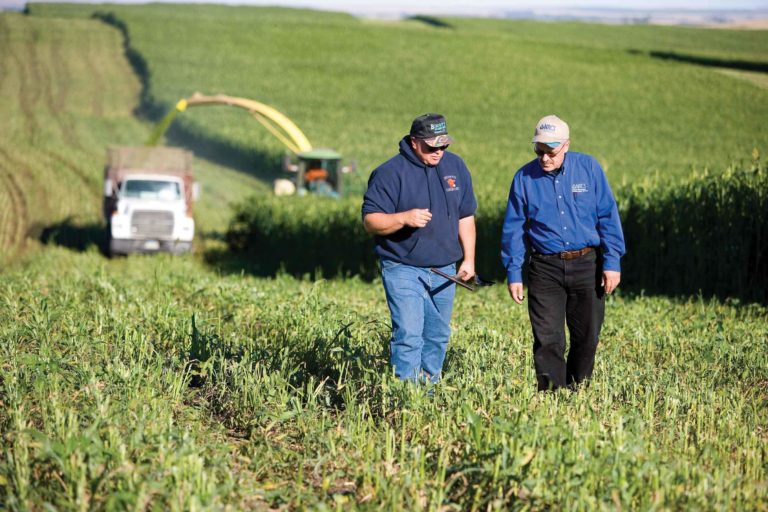As weather-related disruptions become more frequent and intense, climate resilience has become a new goal of businesses, organizations and communities around the world. Many farmers and ranchers are thinking about it too. But what does resilience really mean? How can it become a management goal on farms and ranches, and can progress toward it be measured?
Resilience is usually thought of as the ability to “bounce back” from a damaging disturbance or shock, but if you dig a little deeper into the science, you learn there is a lot more to it. Research shows that resilient farming systems rely on three different kinds of adaptive capacity to sustain performance in the face of change: response, recovery and transformation. Each type of adaptive capacity contributes to resilience in a different way, and resilient systems tend to exhibit all three capacities.
Response capacity describes how your operation copes with climate-related challenges as they happen—both those that are expected and those that are not—in order to avoid or reduce potential damages and to capture new opportunities. Recovery capacity involves having the reserves needed to swiftly and efficiently return to full function when weather-related events have damaged your operation in some way. Transformation capacity means having the ability to make fundamental changes to your operation that enhance its response and recovery capacity in the face of changing conditions now and into the future.
Thinking about resilience in this way—as a set of complementary capacities—helps you keep in mind the full range of options for managing climate risks to your operation. It also provides a useful way to assess your current risk management strategies and adjust them if needed in order to strengthen the overall resilience of your business.
Cultivating Response Capacity
The owners of Full Belly Farm, a 400-acre diversified organic farm in Northern California, have taken a number of adaptive actions to improve water conservation and thus the farm’s capacity to respond to prolonged drought and erratic rainfall. These actions involve minor changes to the existing system including a switch to more drought-tolerant cover crops, the addition of cover crop mulches to conserve soil moisture and upgrading to more water-efficient drip and micro sprinkler irrigation systems. All of these actions serve to reduce the risk of specific threats—drought and erratic rainfall—to farm production, but do little to reduce the risk of other weather-related challenges such as more flooding rains, warmer winters and higher pest pressures.
Along with using targeted practices to manage specific risks, as was done at Full Belly Farm, response capacity also entails using practices that provide more comprehensive risk management benefits. In other words, response capacity enhances the overall resilience of operations to both expected and unexpected disturbances and shocks.
For example, many farmers and ranchers who operate highly diversified systems appreciate the flexibility that diversity gives them when it comes time to make management decisions based on actual or projected weather conditions. Grain and cattle producers like Gabe Brown in Bismarck, N.D., and Gail Fuller in Emporia, Kan., use dynamic crop rotations and cover crop cocktails in their dryland production systems. Both producers plant crops throughout the growing season, which gives them the ability to fine-tune their crop rotation plan to current weather conditions.
“That’s the beauty of the diverse system of ours,” Brown said. “At times, we want to plant the cover crop, and then if the weather conditions change, maybe it’s dry, we’ll change the mix of that species a bit for more crop types that can handle drier conditions, or vice versa. It just makes management so much easier.”
Fuller, who produces cash crops and livestock on a 2,000-acre dryland farm, appreciates that cover crop cocktails allow him to meet multiple goals. “The first thing we do is look at the resource concern we have in a particular field before we design the mix for it,” Fuller said. “Are you going to graze it? What time of the year are you planting it? What will the weather be like? When you guess wrong, there’s still going to be something there that will grow. The more diversity we put in that mix, the more it protects us.”
Dick Cates in Spring Green, Wisc., and Texas rancher Gary Price have both used managed grazing to produce quality beef and to restore native ecosystems on their land. Cates designed a managed grazing system to revitalize a native oak savannah on his farm and to restore a trout stream that runs through his pastures. Price has restored nearly 2,000 acres of native tallgrass prairie on his ranch using managed grazing, brush clearing and control, the reseeding of degraded croplands to native grasses and the restoration of wetlands. The restored ecosystems serve to buffer these operations from many climate-related weather effects, including flooding rains and drought, hot and cold temperature extremes, high winds and changes in seasonal weather patterns.
Innovative practices associated with diversification—such as cover crops, dynamic crop rotation, the integration of livestock into crop production, and pasture cropping—enhance both the response capacity and general resilience of the production system in a number of ways. Systems that use these practices spread production risks through the season by including crops that differ in their sensitivity to specific weather-related disturbances. Diversification and ecosystem restoration can also reduce production costs because the biodiversity in the system can reduce or eliminate the need for inputs such as fertilizers, pesticides and irrigation.
Crop and livestock diversification goes hand-in-hand with product and marketing diversification, which adds another dimension to response capacity and resilience. Spreading marketing risk among different markets can buffer an operation against shocks and, when high-value products or markets are included in the mix, can increase profitability. Because high-value direct and direct-wholesale markets often demand uncommon and value-added products, they offer a financial incentive for diversifying crop production and selecting unique crop cultivars that are well-suited to regional growing conditions.
Cultivating Recovery Capacity
Holding some critical resources in reserve is key to the recovery capacity of your operation. These reserves can be natural (feed and forage, soil health, biodiversity), human (management experience, ease with loss and change), social (community support, knowledge, skills, public assistance), financial (insurance and disaster payments, savings, access to capital) or physical (backup and alternative energy sources, storage, shelf-stable products). Resilient farms and ranches accumulate reserves across the full range of resources under management.
Jim Koan appreciates the way that recent weather challenges have forced him to think outside the box, anticipate what could go wrong and plan for the worst. The Flushing, Mich., apple grower began on-farm production of hard cider—JK Scrumpy’s—in part to enhance the recovery capacity of his operation. By processing a portion of his apples into hard cider in years when yields are high, he has a non-perishable product he can sell in years when weather disrupts production. This helps him maintain his cash flow. “In 2012, we had only had 10 percent of our apple crop. I had half a million dollars invested in those apples,” Koan said. “That was not as big an issue for me as it would have been if we hadn’t had JK Scrumpy’s. I can walk away comfortably saying that I actually made a profit in 2012.”
Tom Trantham sees a recovery strategy in the highly diverse, pasture-based system that he employs on his Pelzer, S.C., dairy. Known as the 12 Aprils system, Trantham no-tills short-season annual forages into a perennial grass pasture. This dynamic system allows him to produce high-quality forage all year and to quickly recover from mistakes or unexpected weather. “There’s always a challenge in farming,” Trantham said, “but with my system, I am able to adjust. If one crop goes, another one’s put right in. But when you’ve got a hundred acres of corn silage and you lose it, you don’t have another shot until next year, so you’re done for.”
Investing in recovery reserves, like managing for the accumulation of natural, human and social resources, challenges traditional notions of economic efficiency because it redirects resources away from narrow production goals; however, recent research suggests that resilience and efficiency goals are complementary, and a balance of both is required to support the sustainability of the system.
Cultivating Transformation Capacity
Ultimately, the resilience of an agricultural business depends on taking a long view of the operation as a whole. What kinds of fundamental changes in production system practices, enterprises and markets could you make to enhance the overall resilience of your operation now and in preparation for the future?
Implementing transformation capacity involves making major adjustments that significantly alter the existing production system by changing the relationships among the people, crops, livestock and land in order to enhance the overall resilience of the operation. These kinds of transformative changes could involve shifting from monoculture to diversified crop production, integrating livestock into cropping systems, shifting from housed to pasture-based livestock production or switching from low-value commodity markets to diversified high-value direct and wholesale markets.
Trantham’s pasture-based dairy system boasts many resilient characteristics, but it was not always that way. Like many American farmers feeling the pain of consolidation in the agricultural sector during the 1980s, Trantham was producing a lot of milk in a conventional operation but barely turning a profit. “I went through some really rough times in those days. We all did,” he recalled. Although he had long been among the top milk producers in his state, rising feed and other input costs, and falling prices left him with few options when he was refused an operating loan in 1987. After some research into intensive grazing practices, he successfully guided the transition of his 90-cow dairy from a feed-based to the forage-based production system he continues to use today. He has dramatically lowered his costs while increasing herd health, milk quality and soil health.
Trantham’s transformation from commodity dairyman to specialty milk retailer was complete when the Happy Cow Creamery opened in 2002. Whole milk, chocolate milk, buttermilk and eggnog are processed on farm and sold into regional direct-wholesale markets and at an on-farm store that also sells a diverse line of mostly locally sourced fresh and processed products including produce, fruits, butter, cheeses and meats.
Recall that Colorado fruit grower Steve Ela uses direct marketing strategies to remain in business in a region that has lost 75 percent of its fruit growers over the last 20 years. His family farm was on the same downward path as others in the region when he took over management in 1990. With declining profits taking a toll on family finances, he looked to direct marketing to turn the farm around. “We started making changes because of bad economics and now we direct market 100 percent of our fruit,” Ela said. “We’ve completely changed our business model in 12 years. Fortunately it’s worked; we’re still here.” Direct markets have also opened up new opportunities for him to diversify crops because his customers are willing, even eager, to try something new.
A good time to consider transformative changes to your operation such as those made by Trantham and Ela is when it looks like the costs—ecological, social or economic—of maintaining your current operation are growing unacceptably high, your operation begins to consistently fall short of meeting your goals, or it becomes clear that change is inevitable because of growing environmental, social or economic challenges.



